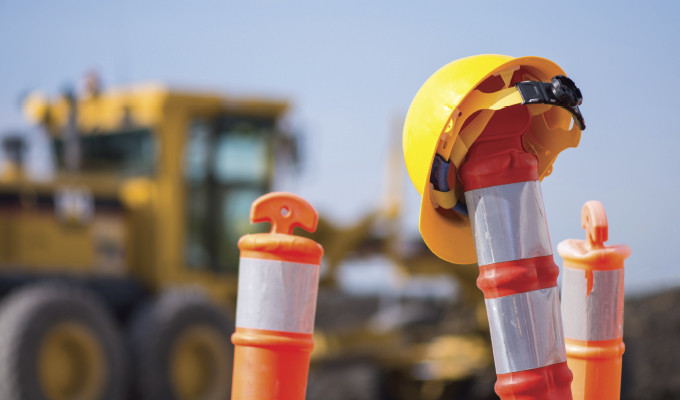In the construction industry, most agree safety should be the number one priority, putting heavy emphasis on training precautions on worksites. Unfortunately, for many organizations, that is not a reality. In 2017, a National Safety Council survey found 58 percent of Americans working in construction—the industry that sees the most workplace fatalities each year—feel safety takes a backseat to productivity and completing job tasks. Fifty-one percent surveyed say management does only the minimum required by law to keep employees safe, and 47 percent say employees are afraid to report safety issues.
With this mentality being so prevalent, it is important for organizations raise awareness for what should matter most—keeping employees safe. Elzinga & Volkers, an award-winning construction safety organization, takes safety seriously and believes keeping employees protected should be non-negotiable.
4,000-DAY MILESTONE
In May, Elzinga & Volkers reached 4,000 days of no lost time due to any construction-related incidents. This milestone was made possible because of strong leadership and dedication from key executives that truly care about the well-being of employees. Tactics like making safety a daily on-site discussion, continuous trainings, and support from all team members to keep safety top-of-mind no matter the cost or time, are just a few requirements to keep a worksite safe.
Over the last 10 years, safety has become more of a concern in the construction industry, but, due to its importance, could benefit from receiving even more attention. When I began at E&V, hardhats were mandatory but not always enforced. Monthly safety meetings consisted of a safety video being played but with minimal interaction. Safety was not a daily topic of discussion. We felt we were a safe company, but were certainly not recognized as such by the industry.
To improve the culture, Elzinga & Volkers hired a dedicated safety director, which led to the development of new programs and initiatives to ensure a protected workplace.
There are several important factors to consider when making safety a priority, including establishing a safety committee, having a dedicated leadership team, providing support to employees, and making a safety an ongoing conversation. The following steps allowed Elzinga & Volkers to achieve safety accolades and build a safety culture engrained in the entire organization:
Employee-run safety committee: This committee helps to encourage employee involvement in safety training at the monthly meetings—creating an atmosphere that requires more people to participate.
Leadership team: It is vital to have a team that supports safety regardless of the time and cost it takes. A good leadership team allows each employee the ability to stop work at any time if unsafe practices are being used. This is where change is made, from the top down.
Make it personal: We believe it is key to lead from the heart. Our entire team wants employees to go home to their families every night. Safety for us is not about insurance premiums or liabilities, but it is about protecting people personally.
Talk about it: At Elzinga & Volkers, we celebrate safety. It is talked about at every meeting, and it is engrained in all employees, regardless of whether they work in the office or in the field. We hold each other accountable for staying safe. It is the way we “choose” to work and not viewed as the way we “have” to work.
REAL CHANGE
Over the past several years, The Michigan Occupational Safety and Health Administration (MIOSHA) has built a working relationship with contractors. MIOSHA is enforcing the fatality causing and frequently violated standards, and spending less time writing violations on paperwork, signage, and items that are less likely to cause injury. With the help of MIOSHA, real change in safety standards will continue to occur within our industry.
Each year, Elzinga & Volkers holds a safety week to educate all professionals in the industry. Free training sessions are held on the following topics: first aid, CPR and AED, aerial lift training, qualified rigger, fall protection, silica standard, and scaffolding. Implementing programs nationwide will benefit the industry and employees in the long run. Staying informed on the latest regulations may take time, but can ultimately lead to saving a life.
I am inspired by caring for the workers around me—these employees are my friends and part of my work family. I would not want an accident to happen I could have helped prevent.
LEAD BY EXAMPLE
If management is serious about putting the safety of their employees first, they will need to demonstrate this through action. Simply telling employees how they need to act may not be well-received. Management needs to be the example by exemplifying safety standards day in and day out and following the guidelines. It is not good practice to tell your employees they need to wear a hard hat and safety glasses but not use them yourself when you show up on-site. Making an emotional connection to safety with employees can help them realize the true importance of taking that extra step to make safety a priority.
SAFETY FIRST
To show the ultimate care for employees, the childhood phrase “safety first” should always apply to the workplace. Safety should not be an afterthought, but a requirement to anyone in the construction field. By giving the time and dedication to safety, workers can be assured safety is the driver of the industry, and work can only be done with the employees’ well-being at the forefront.
ABOUT THE AUTHOR
Tony Roussey is the chief operating officer at Holland-based Elzinga & Volkers Construction Professionals. Along with oversight of all construction operations, Roussey leads a culture of safety at E&V that has led to recognition on a national level. The firm has been awarded a National Excellence in Safety award by the Associated Builders and Contractors and celebrated 11 years without a loss-time injury. www.elzinga-volkers.com.
____________________________________________________________________
Modern Contractor Solutions, August 2018
Did you enjoy this article?
Subscribe to the FREE Digital Edition of Modern Contractor Solutions magazine.



